Quality of the Environment in Japan 1990
c. Place of measurement
Measurement shall be done outdoors at a point the noise at which is considered to represent the noise of that area as well possible or a point where a noise problem is likely to arise.
In the case of areas facing roads, the measurement point shall in principle be facing the road and one meter toward the road from any building which is used as a residence, hospital, school, or the like.
It is, however, provided that when a building adjoins a road which does not have a sidewalk, measurement shall be carried out at the edge of the road.
Any places such as factory or business establishment sites which generate considerable noise, building construction sites, airport grounds, and railway grounds shall not be used as measurement points.
d. Time of measurement
Measurement shall be done at a time the noise at which is considered to represent the noise of that area as well as possible or a time when a noise problem is likely to arise.
In the case of areas facing roads which are affected mainly by road traffic noise, measurement shall be carried out at least once in the morning and once in the evening and at least twice in the daytime and twice in the nighttime, with special attention being paid to those times at which people get up and go to bed.
e. Period for achieving environmental quality standards
Efforts shall be made to achieve and maintain the environmental quality standards for each type of areas in accordance with the follwing categories and in conjunction with the development of the policies of!.
(a) For areas other than areas facing roads efforts shall be made to achieve the environmental quality standards promptly following the setting of the said standards.
(b) For areas facing roads efforts shall be made to achieve the environmental quality standards within 5 years of the setting of the said standards.
It is, however, provided that for areas facing trunk roads which carry heavy traffic loads making it very difficult to achieve the said environmental quality standards within that time, efforts shall be made to achieve such standards as quickly as possible after the ending of the said 5-Year period.
f. Policies for the achievement of environmental quality standards
While the achievement of the environmental quality standards requires the energetic cooperation of the persons who generate the noise, the government shall for its part push forward the following policies in its endeavours to achieve and maintain the said standards. In addition, with regard to the implementation of such policies, appropri-ate measures shall be established to provide fiscal, financial, and tax assistance and special consideration shall be given to small and medium-scale enterprises.
(a) Reinforcement of regulations With regard to the reinforcement of regulations, when required as part of the achievement of environmental quality standards the regulatory standards relating to factory noise and the permissible limits set for car noise shall be reviewed.
(b) Optimization of land use Efforts shall be made to optimize land utilization with the basic objective being to separate factories and dwellings, and adjustments shall be encouraged with respect to establishment or expansion of noise-generating factories. In the formulation and implementation of plans for area development full consideration shall be given to the prevention of noise pollution, and in the application of laws relating to land and buildings such as the City Planning Law and the Building Standard Law consideration shall be given to helping to achieve the standard values set out in Article.
(c) Promoting the installation and improvement of noise prevention equipment In order to make legal controls more effective, the installation of noise prevention equipment and the use of low-noise facilities by fac-tories shall be promoted, and with regard to small-and mediumscale enterprises which have difficulties in carrying out such measures consid-eration shall be given to such enterprises moving into an industrial estate.
In addition, the implementation of such measures to control noise sources shall be accompanied when necessary by the provision of public facilities such as green buffer zones.
(d) Comprehensive policies for road traffic noise
With respect to areas facing roads, in addition to the above measures to control noise, general policies shall be promoted such as improving cars to make them quieter, improving the structure of roads to reduce traffic noise, promoting urban renewal, implementing traffic regulations to the extent that it does not hinder the smooth flow of traffic, and strengthening traffic controls.
In addition, with regard to the construction of new roads, along with other policies aimed at the reduction of road traffic noise full consideration shall be given in the formulation and implementation of the road planning and planned use of land around the roads in order to facilitate the achievement of environmental quality standards in areas facing roads.
(e) Monitoring system
In order to be able to ascertain and evaluate noise accurately for the proper enforcement of regulatory measures, efforts shall be made to provide and reinforce a system with the requisite capability to monitor noise at all times.
(f) Promoting the development of noise-prevention technology
In order to prevent noise pollution, the development of technology for reducing noise for low-noise machinery and vehicles, research and development into noise transmission mechanisms and insulation effects, and research into the effect of noise on the human body shall be promoted.
(g) Assistance for local governments For the smooth progress of noise control policies local govern-ments shall be given assistance. Special consideration shall be given to the implementation of plans for the control of pollution which are based on the Basic Law for Environmental Pollution Control.
(h) Enlightening the public The public shall be given the necessary enlightenment to contrib-ute to the prevention of nighttime noise, especially that accompanying latenight business operations and noise accompanying the use of acous-tical equipment and musical instruments in the home.
With regard to road traffic noise particularly strong efforts shall be made to make car drivers conscious about noise prevention and to obtain their cooperation in this respect.
g. Reviewing environmental quality standards
(a) Environmental quality standards shall be modified when neces-sary to reflect advances in knowledge relating to the effect of noise, changes in social evaluation thereof, and the progress of noise measure-ment technology.
(b) Area type designations shall be changed in accordance with changes in the patterns of use of such areas.
h. Exemptions from the application of environmental quality standards
The environmental quality standards herein shall not apply to aircraft, railway, or building construction noise.
(2) Environmental Quality Standards for Aircraft Noise(Dec. 27, 1973)
a. Environmental quality standards
(a) The values of the environmental quality standers are estab-lished for each category of area shown in Table 1. Prefectural governors shall designate the category of area.
(b) The environmental quality standards values referred in para-graph (a) above are measured and evaluated by the following method.
Table 1

Note: Category I area stands for the area for exclusively residential use and category II area for the other area where normal living conditions should be preserved.
1) Peak levels in dB (A) of aircraft noise which is higher than background noise level by 10 dB (A) or more, and the number of such aircraft, should be recorded for, in principle, seven consecutive days.
2)Measurements should be carried out outdoors, at points selected as representing the points of aircraft noise in the area concerned.
3)Timing of measurements should be chosen as representing the duration of aircraft noise at the point of measurements, taking into consideration the flight conditions and meteorological conditions includ-ing wind directions.
4)The aircraft noise shall be evaluated as follws. The WECPNL values for each day will be calculated from peak levels of aircraft noise and numbers recorded under subparagraph 1)above using the following equation. The energy mean of daily WECPNL values thus calculated is the noise level in question.

5)The instrument of measurement to be used in any one of the following: the sound level meter provided for in JIS C-1502, precision sound level meter under IESC Pub/179, or any other equivalent instru-ment.
In these cases, A-weighted calibration and slow dynamic response should be used.
(c) The environmental quality standards provided for in paragraph (a) above shall not apply to areas around airports where there are 10 or less daily landings and take-offs and around those in remote islands.
b. Target dates
(a) In areas around public airports and others, the environmental quality standards shall be attained and maintained before the target dates specified for each category of airports shown in Table 2. In these cases, in the areas where target dates are more than five years away, the improvement goals in Table 2 shall be attained as an interim measure in order to facilitate the attainment of the environmental quality standards step by step.
(b) In areas around airports used by the Self-Defense Forces, etc., efforts shall be made to attain and maintain the environmental quality standards before same target dates as those for category of public airports under similar conditions in Table 2, considering the average number of landings and take-offs, type of aircraft and concentration of houses.
Table 2
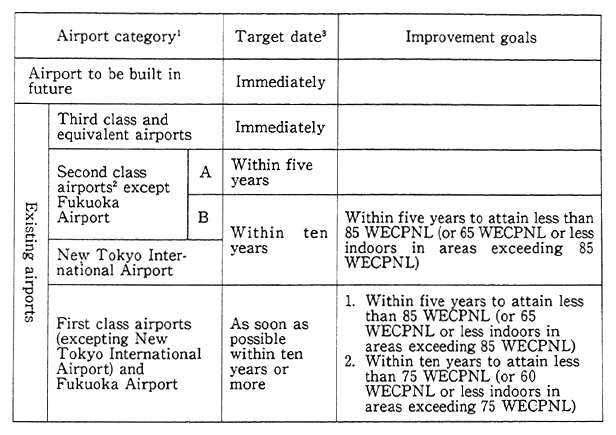
Notes:1. Airports were categorized as of effective date (December 27, 1973) of these standards.
2. Airports of category B of second class are those where there are regular commercial landings and take-offs of aircrafts equipped with turbo-jet engines, and category A means the others.
3. The target dates are to be counted from the date of establishment of the environmental quality standards
(c) In areas where it is deemed difficult to attain the environmental quality standards before the target dates in spite of the comprehensive measures to be taken to control aircraft noise, such measures should be taken as sound-proofing of the houses of people wishing to remain in the area, with a view to obtaining the indoor conditions effectively equiva-lent to ones where the environmental quality standards are being met, and maximum endeavors shall be made to attain the environmental quality standards as soon as possible.
(3) Environmental Quality Standards for Shinkansen Superexpress Railway Noise (July 29, 1975)
a. Environmental quality standards
(a) The values of the environmental quality standards are establi-shed for each category of area shown in Table 1. Prefectural governors shall designate the category of area.
Table 1

Note: Category I area stands for the area for mainly residential use and category II area for other purposes, including commercial and industrial areas, where normal living conditions should be preserved.
(b) The environmental quality standards values referred in para-graph (a) above are measured and evaluated by the following method.
1) Measurements should be carried out by recording the peak noise level of each of Shinkansen trains passing in both directions, regarding, in principle, 20 successive trains.
2)Measurements should be carried out outdoors and in principle at the height of 1.2 meters above the ground. Those measurement points should be selected, which are seen to represent the Shinkansen railway noise levels in the area concerned, as well as those points where the noise is posing a problem.
3) Measurements are to avoided when special weather conditions prevail and when train speeds are lower than normal.
4)The Shinkansen railway noise should be evaluated by the energy mean value of the higher half of the measured peak noise levels.
5) Instruments that meet the requirements listed in Article 88 of the Measuring Law (No. 207 of 1951) should be used for the measurements, with A-weighted calibration and slow dynamic response.
(c) The environmental quality standards provided for in paragraph (a) above shall apply to Shinkansen railway noise from 6 am. to 12 midnight.
b. Target dates
(a) Efforts shall be made in cooperation with related administra-tions and prefectural governments to attain and maintain the environ-mental quality standards before the target dates specified for each classification of zones along the railway line as shown in Table 2. In areas where it is deemed difficult to attain the environmental quality standards before the target dates in spite of the comprehensive measures to be taken to control the Shinkansen railway noise, such measures should be taken as sound-proofing of houses, with a view to obtaining the indoor conditions effectively equivalent to one where the environmental quality standards are being met. When endeavors fail to satisfy the standards within target dates, such efforts are to be continued to attain them as soon as possible.
c. Implementation policy for noise controls
(a) In implementing noise controls for the Shinkansen superexpress railway "a" areas shall be given priority and special attention.
(b) The methods of implementing noise controls for "b" and "c" areas along existing lines shall reflect the state of progress of policies to overcome obstacles relating to the development and implementation of sound source control technology, the system for such implementation, and financial measures, all with respect to "a" areas.
Table 2
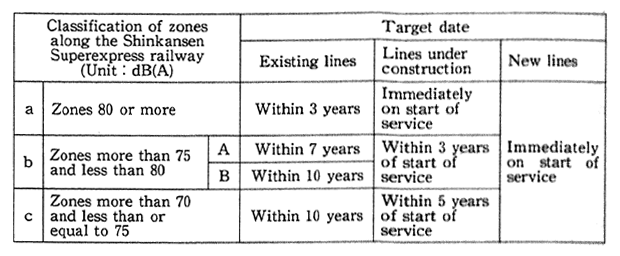
Notes: 1. The subdivision "A" under the "b" classification stands for zones within the region in which there is a succession of category I area, and subdivi-sion "B" stands f r zone except subdivision "A"
2. The existing lines, lines under cibstruction, and new Lines in the table refer to the following.
(1) Existing Lines The Tokyo-Hakata Section.
(2) Lines Under Construction: The Tokyo-Morioka, Omiya-Niigata. and Tokyo -Narita sections
(3) New Lines : New lines being those other than the lines of (1) and (2) above
3. With respect to existing Lines, the target dates for achievenment are calcu-alted from the date when the environmental quality standards are established.
3. Environmental Water Quality Standards (Dec. 28, 1971, Amendments 1974, 1975, 1982, 1985)
(1) Standards related to the Protection of Human Health
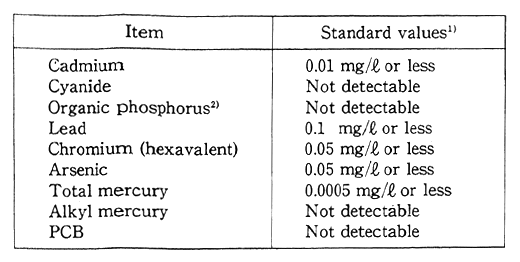
Notes: 1. Maximum values. But with regard to total mercury, standard value is based on the yearly average value.
2. Organic phosphorus includes parathion, methyl parath-ion, methyl demoton and E. P. N.
3. Standard value of total mercury shall be 0.001 mg/l in case river water pollution is known to be caused by natural conditions.
(2) Standards related to the Convation of the Living Environment
a. Rivers
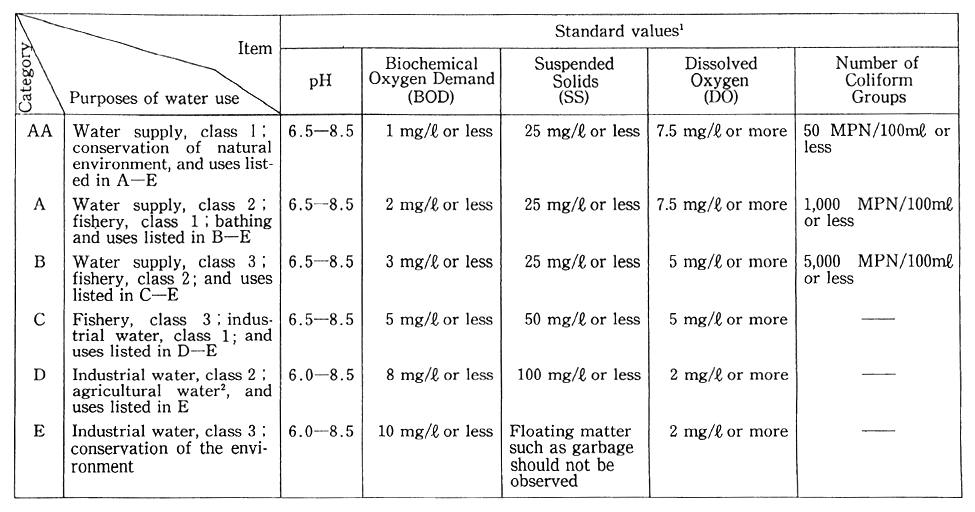
Notes: 1. The standard value is based on the daily average value. The same applies to the standard values of lakes and coastal waters.
2. At the intake for agriculture, pH shall be between 6.0 and 7.5 and dissolved oxygen shall not be less than 5 mg/l. The same applies to the standard values of lakes.
3. Conservation of natural environment : Conservation of scenic spots and other natural resources.
4. Water supply, class 1 - Water treated by simple cleaning operation, such as filtration.
Water supply, class 2 - Water treated by normal cleaning operation, such as sedimentation and filtration.
Water supply, class 3 - Water treated through a highly sophisticated cleaning operation including pretreatment.
5. Fishery, class 1 - For aquatic life, such as trout and bull trout inhabiting oligosaprobic water, and those of fishery class 2 and class 3.
Fishery, class 2 - For aquatic life, such as fish of the salmon family and sweetfish inhabiting oligosaprobic water and those of fishery class 3.
Fishery, class 3 - For aquatic life, such as carp and crucian carp inhabiting fタ-mesosaprobic water.
6. Industrial water, class 1 - Water given normal cleaning treatment such as sedimentation.
Industrial water, class 2 - Water given sophisticated treatment by chemicals.
Industrial water, class 3 - Water given special cleaning treatment.
7. Conservation of the environment-Up to the limits at which no unpleasantness is caused to people in their daily life including a walk by the riverside, etc.
b. Lakes (natural lakes, and artificial reservoirs with 10 million cubic meters of water or above)
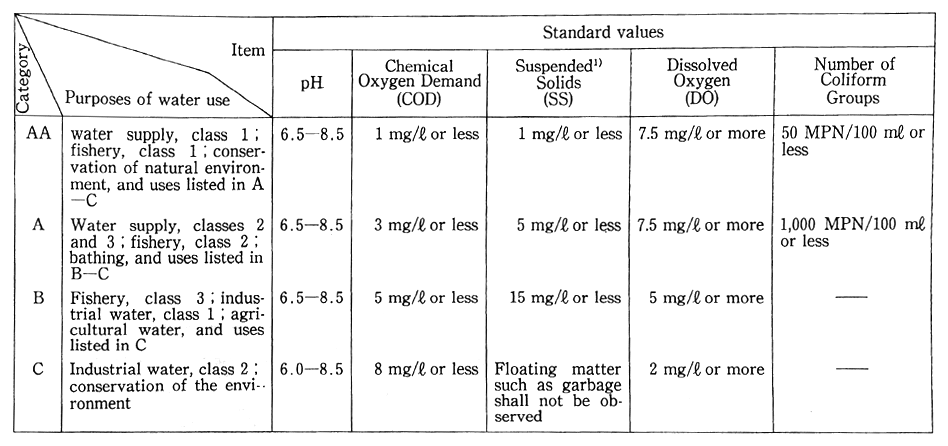
Notes: 1. With regard to fishery, classes 1, 2 and 3, the standard value for suspended solids shall not be applied for the time being.
2. See notes for rivers.
3. Fishery class 1 - For aquatic life,such as salmon inhabiting oligotorophic lake type waters, and for those of fishery class 2 and 3.
Fishery class 2 - For aquatic life, such as fish of the salmon group and sweet fish inhabiting oligotorophic lake type waters, and for those of fishery class 3.
Fishery class 3 - For those aquatic life, such as carp and silver carp inhabiting eutrophic lake type waters.
4. Industrial water class 1 - Water given normal treatment such as sedimentation. Industrial water class 2 - Water given sophisticated treatment such as chemical injection or special treatment.
5. Conservation of the environment-Up to the limits at which no unpleasantness is caused to the people in their daily lives including a walk along the shore.
c. Nitrogen and phosphorus in lakes and reservoirs
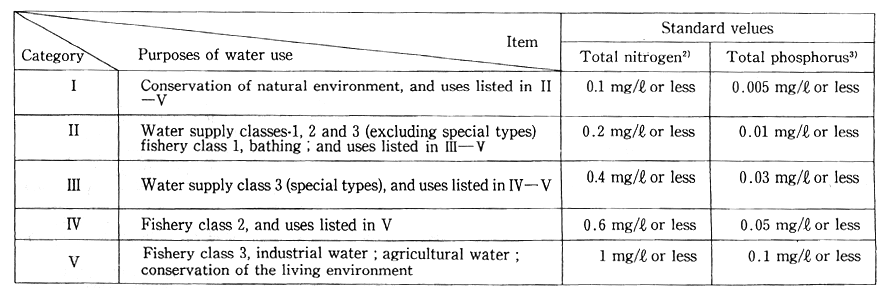
Note: 1. Standard values are set in terms of annual averages.
2. Standard values for total nitrogen are applicable to lakes and reservoirs where nitrogen is a causal factor of the growth of phytoplankton.
3. Standard values for total phosphorus are not applicable to agricultural water uses.
4. Conservation of natural environment-Conservation of scenic points and other natural resources.
5. Water supply class 1 - Water treatment by simple cleaning operation such as filtration.
Water supply class 2 - Water treatment by normal cleaning operation such as sedimentation and filtration.
Water supply class 3 - Water treatment by sophisticated cleaning operation including pretreatmant. ("special types"mean water treatments by special cleaning operation in which removal of smelling substances is possible.)
6. Fishery class 1 - For aquatic life, such as fish of the salmon group and sweet fish, and for those of fishery class 2 and 3.
Fishery class 2 - For aquatic life, such as smelt and for those of fishery class 3.
Fishery class 3 - For aquatic life, such as carp and silver carp.
7. Conservation of the environment-Up to the limits at which no unpleasantness is caused to the people in their daily lives including a walk along the shore.
d. Coastal waters

Notes: 1. With regard to the water quality of fishery, class 1 for cultivation of oysters, the number of coluform groups shall be less than 70 MPN/100 ml.
2. Conservation of natural environment-Conservation of scenic points and other natural resources.
3. Fishery, class 1 - For aquatic life, such as red sea-bream, yellow tail, seaweed and for those of fishery class 2.
Fishery, class 2 - For aquatic life, such as gray mullet, layer, etc.
4. Conservation of the environment-Up to the limits at which no unpleasantness is caused to the people in their daily lives including a walk along the shore.
4. National Emission Standards
(1) Sulfur Oxides
a. Sulfur oxides emission standard
The emission standard for sulfur oxides which applies to a given sulfur oxides emitting facility may be calculated by inserting a value K, specified under Cabinet Order for the region that the facility is located, into the following equation:
q=K×10-3×He2
Here, q is the hourly volume of sulfur oxides emitted (in unit of
Nm3) and He, effective height of stack, is the sum of actual height of stack and moke ascent height. The value of K, which varies according to the region, inversely determines the degree of regulation. In other words, a reduction in K means stiffer control standard. The standard for sultur oxides has hence been labeled the "K-value regulation."
The general emission standard for sulfur oxides (the K-value) was strengthened on September 28, 1976,and as a result all of Japan now controlled under sixteen K ranks ranging from 3.00 to 17.5.
b. Regulation on fuel
The regulation on fuel quality under the Article 15 of the Air Pollution Control Law was revised in September 1976. Asahikawa was added to the previous list of 14 areas (Tokyo, Osaka, etc.).
The regulation standards were upgraded to a sulfur content ranging from 0.5 to 1.2%. Regulation of Sulfur Oxides Emission (K-value)
(a) General standards
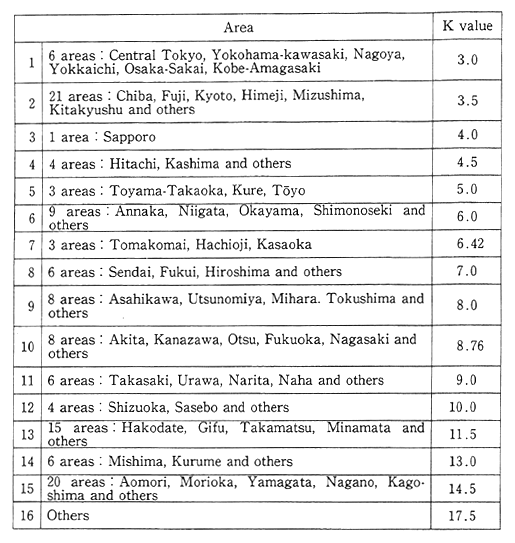
(b) Special standards

Note: Special standards are applied to newly constructed facilities only.
(2) Soot and Dust (Latest amendment, May 1982)
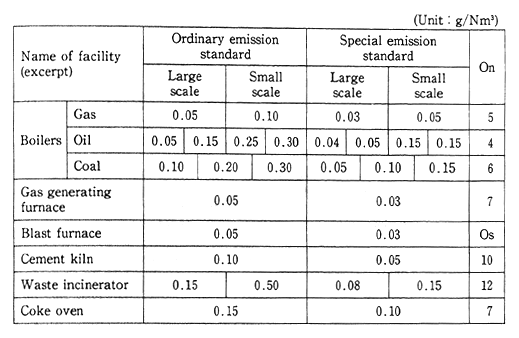
Notes: 1: Prefctures may by decree, set more stringent standards.
2. The gas emission rate of 40,000 Nm3/h is the criterion used for scale classification. However, heavy oil boilers and coal boilers are classified into four and three scales respectively. The criteria for the former ones are 200,000 Nm3/h, 40,000 Nm3/h,and 10,000 Nm33/h000 Nm3/h and 40,000 3 are for the latter ones.
3. The emission concentration shall be converted through the following equation. (Except in the case of blast furnace)
C=21-On/21-OS×Cs
C : Soot and dust emission concentration
On: Oxygen concentration in flue gas (set values in the above table)
Os: Actual oxygen concentration in flue gas
Cs: Actual soot and (lust emission concentration
(3) harmful Substances (June 22, 1971)

Note: Prefectures may, by decree, set more stringent standards.
(4) Nitrogen Oxides (as of Sept. 1983) (Abstract)
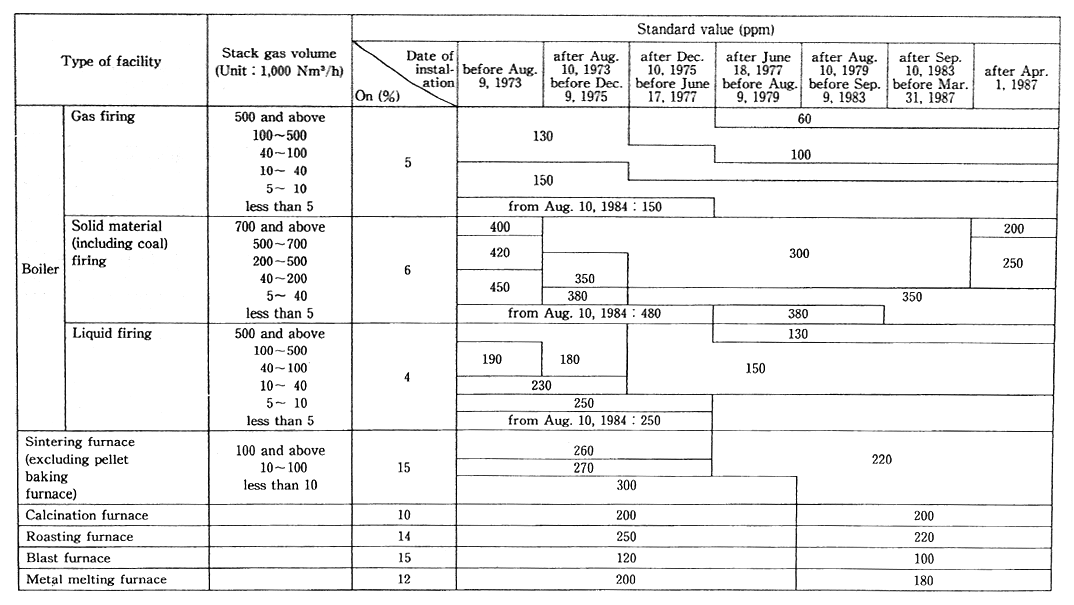
(contd.)
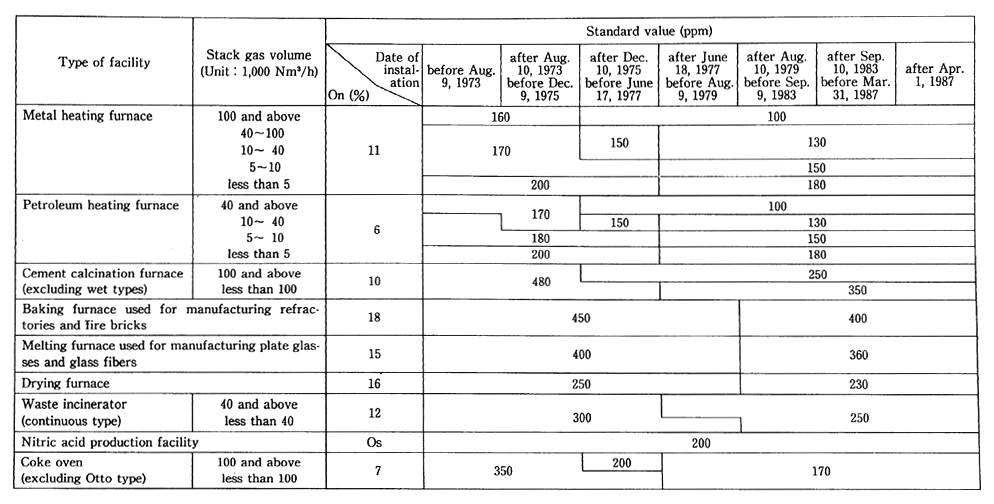
Notes: 1. Reference to unit, the symbol " -" means "and above/less than": e.g. a -b means a and above/less than b.
2. NOx emission concentration shall be converted through the following equation. (Except in the case of nitric acid production faclitie)
C=21-On/21-Os×Cs
C : Nitrogen oxides emission concentration
On : Oxygen concentration in flue gas (set values in the above table)
Os : Actual oxygen concentration in flue gas
Cs : Actual nitrogen oxides emission concentration
(5) Asbestos (December 1989)
The regulately standards for asbestos requires an average ashes-tos fiber level at boundary lines of asbestos manufacturing plants less than 10 fibrt 1 liter.
(6) Offensive Odor Substances (Latest revision, September 1976)
a. Range of reguklatory standards on boundary line
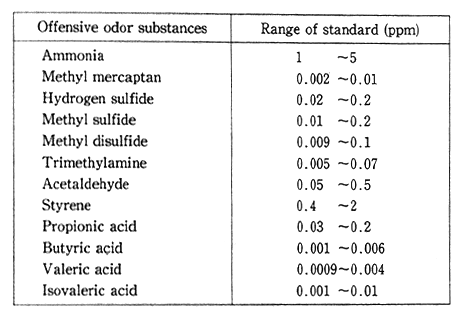
b. Regulatory standards at the outlet* (Excluding methyl mercaptan, methyl sulfide, methyl disulfide, actaldhyde and styrene)
q=0.108×He2
q : Gas emission rate (Unit: Nm3/hr)
He: Effective height of outlet (Unit: m)
Cm: Regulatory standard on Boundary line (Unit: ppm)
* The standards apply to those outlets which are higher than five meters.
(7) Permissible Limits of Motor Vehicle Exhaust Gas
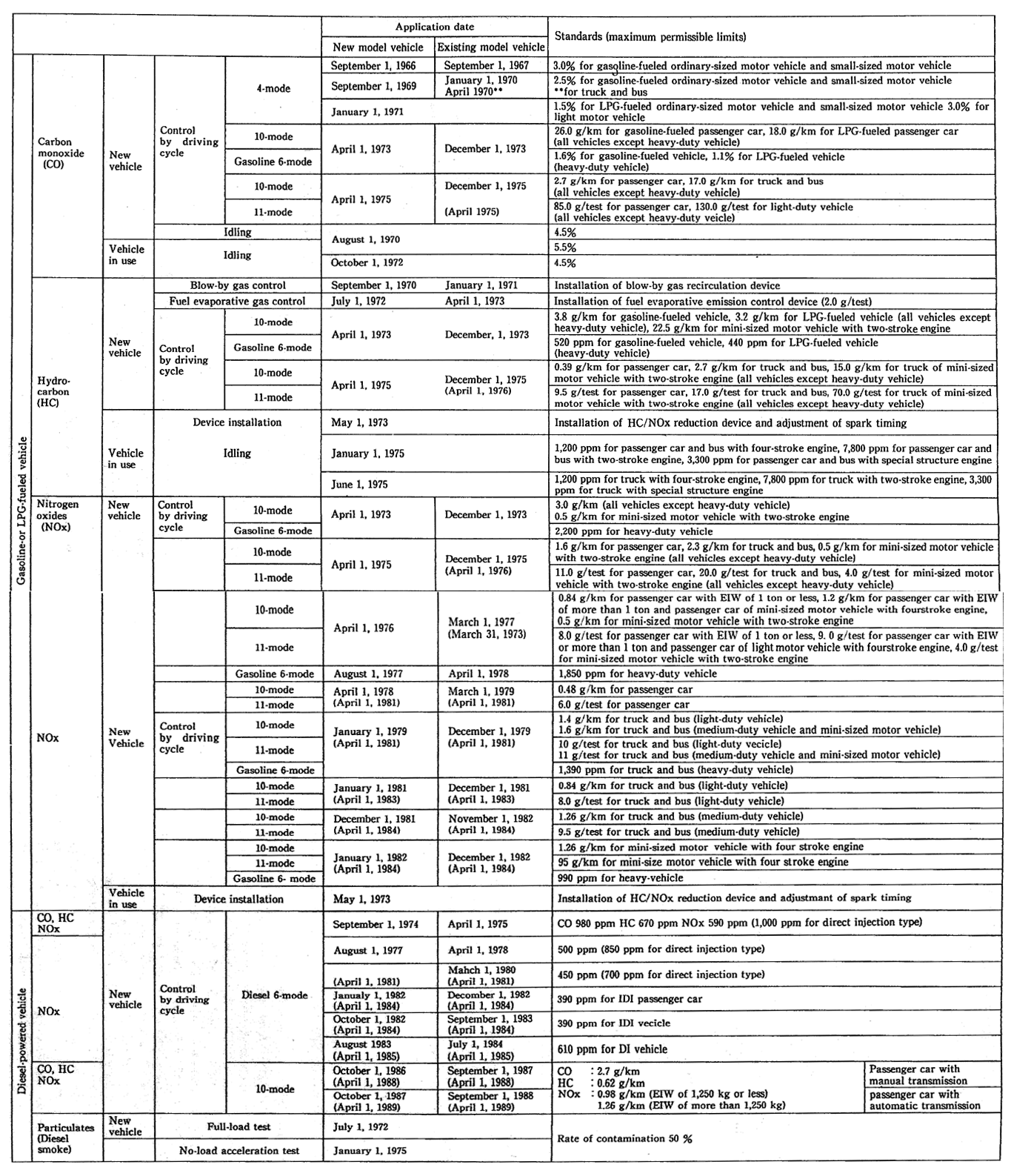
5. National Effluent Standards (June 21, 1971; Amendments 1974, 1975, 1976, 1977, 1981, 1985, 1986)
(1) Substances related to the Protection of Human Health1)Notes : 1. Prefectures may, by decree, set more stringent standards.
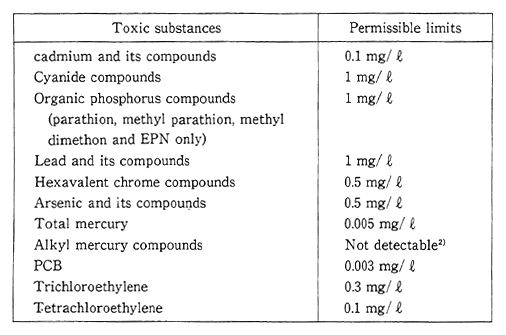
2. By the term "not detectable" is meant that the substance is below the level detectable by the method designated by the Director-General of the Environment Agency
(2) Items related to the Protection of Living Environment 1),2)
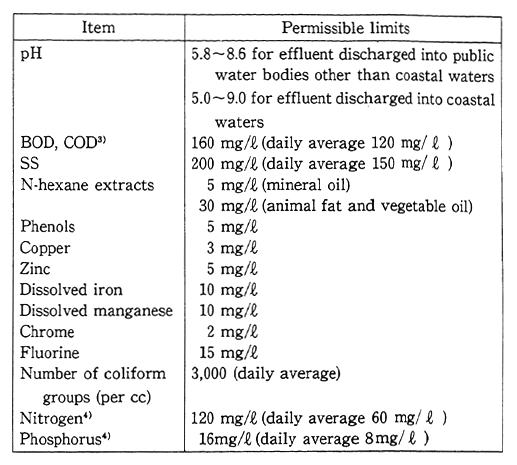
Notes:1. Prefectures may, by decree, set more stringent standards.
2. The standard values in this table are applied to the effluents from industrial plants and other places of business whose vol-ume of effluents per day is not less than 50m3.
3. The standard value for DOD are applied to public waters other than coastal waters and lakes, while standard value for COD is applied only to effluents discharged into coastal waters and lakes.
4. Standard values for nitrogen and phosphorus are applied to lakes and reservoirs in which problems due to eutrophication may occur.
The phosphorus standards are applicable to lakes and reservoirs where water stays for 4 days or longer (excluding those with a chlorine ion content of more than 9,000 mg/l, and those where special dam operations are conducted) out of lakes and reser-voirs with a drainage area of more than 1 Km2 a total surface area of more than 0.1 Km3 limitation does not apply to lakes and reservoirs used as source of tap water). Also covered are rivers and other water bodies designated as "public water areas" flowing into the above lakes and reservoirs.
The nitrogen standards are applicable to lakes and reservoirs where the figure obtained by dividing the nitrogen content of water by the phosphorus content is less than 20 and the phospho-rus content of water exceeds 0.02 mg/l, out of the lakes and reservoirs subject to the phosphorus regulation. Also covered are rivers and other water bodies designated as public water areas flowing into those lakes and reservoirs.
Appendix3: Environmental Statistics
1. Budget and Public Financing
Table 1. Budget for Environmental Conservation by Ministries and Agencies (Initial)
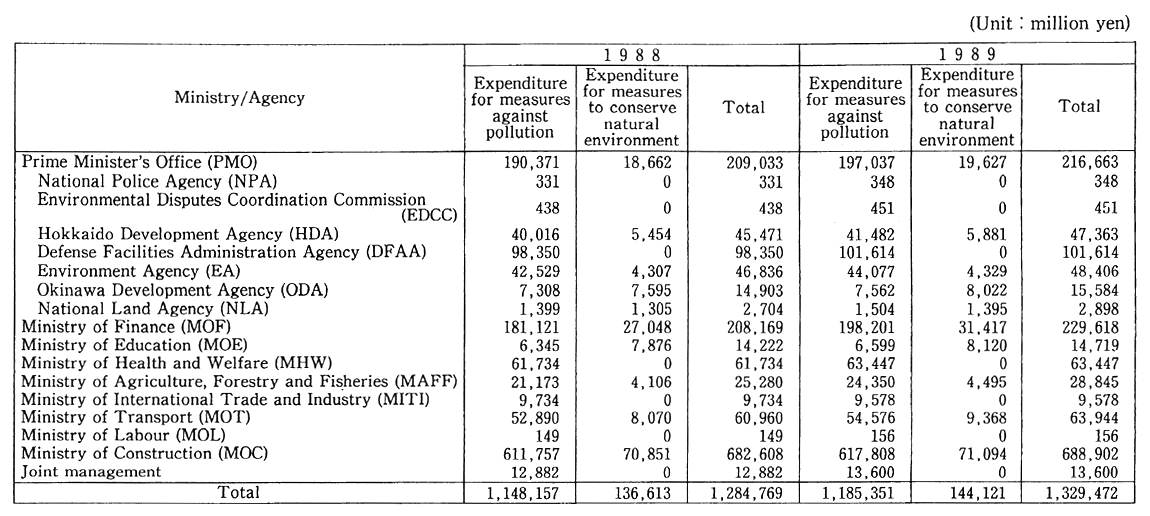
Notes: 1. The expenditure allocated under operating programs are excluded.
2. There are cases in which a simple addition of all figures does not coincide with a figure in "Total," as fractions of 5 and over are counted as a unit and the rest is cast away.
Table 2. Budget for Conservation of Environment by Item (Initial)
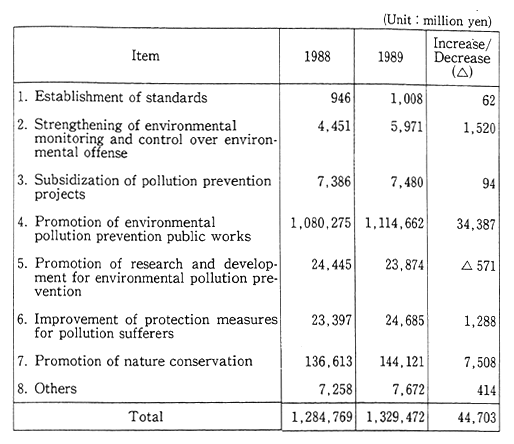
Notes :1. The expenditure allocated under operating programs are excluded.
2. There are cases in which a simple addition of all figures does not coincide with a figure in "Total", as fractions of 0.5 and over are counted as a unit and the rest is cut off.
Table 3 Expenditures for Pollution Control Projects Associated with Institutions Eligible for Financial Investmentsand Loans (Initial Plan)
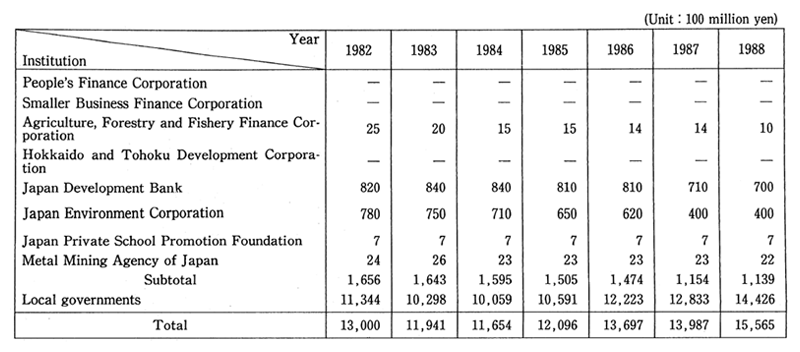
Notes:1. ""Y" denotes the expenditures in which only those related to measures against pollution cannot be taken out because the framework of financial investments and loans is set up while they are combined with loans and projects for other purposes.
2. Necessary loans are also advanced by the Environmental Sanitation Business Finance Corporation, Okinawa Development Finance Corporation, Maritime Credit Corporation and Small Business Promotion Corporation.
Table 4 Project Scale of Japan Environment Corporation
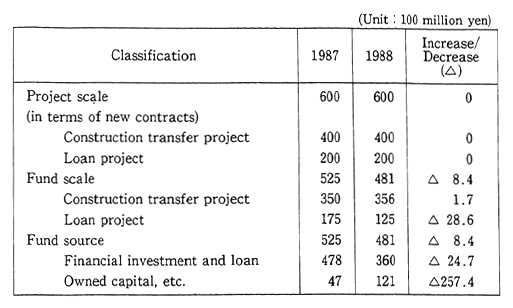
Table 5 Cost for Pollution Prevention Projects covered by EnterprisesNotes: 1. It is stipulated in Article 22 of the Basic Law tor Environmental Pllutution Control that in relation to projects to be carried out by the State or the local governments, an enterpreneur shall bear all or part of the cost required for the project, depending on the degree to which his business activities are deemed causative, in order to prevent the environmental pollution which might be caused by his business activities.
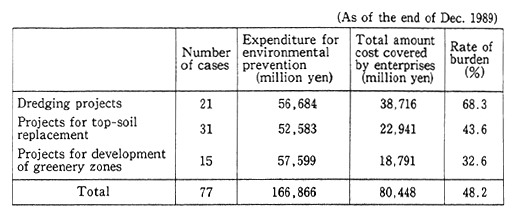
2. As there are projects in which a dredging project and a project for the development of green buffer zone are carried out, the number of cases by project does not coincide with the total number of cases.
3. The expenditure for projects to prevent environmental pollution and the total amount of burden by enterpreneurs are those on a planning basis.
Fig 1. Trends in Anti-Pollution Investment by Big Enterprises
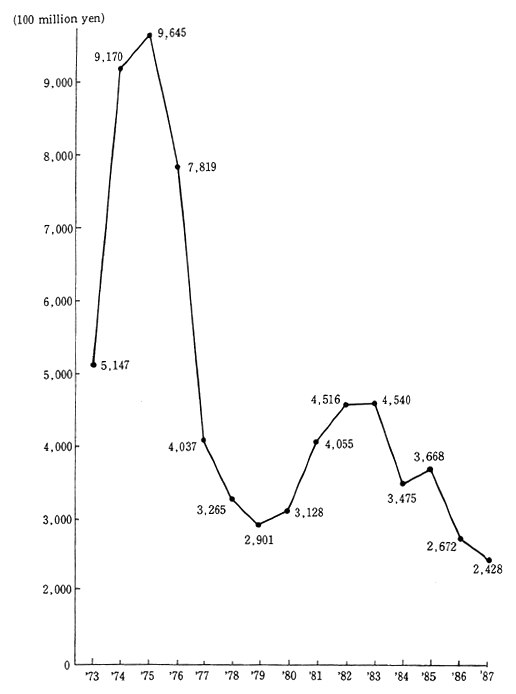
Note:Those enterprises surveyed are manufacturers and other firms with capital of ¥100 million or more.
Source : Survey by the Ministry of International Trade and Industry
2. Settlement of Pollution-related Disputes and Police Handling of Pollution Offences
Table 6 Overview of Pollution-related Disputes
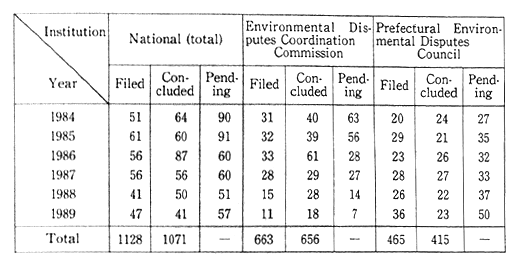
Note : The total for the period is that of the period extending from November 1. 1970 to March 31. 1990.
Source: Environmental Disputes Coordination Commission
Fig. 2 Trends of Pollution-related Complaints
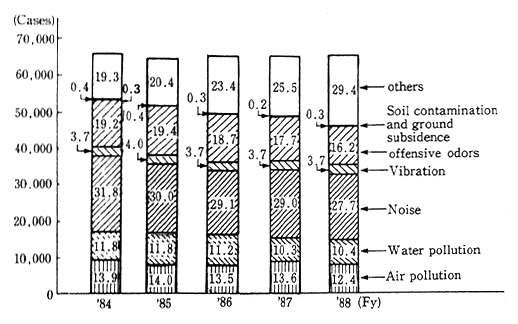
Source : Environmental Disputes Coordination Commission
Fig. 3 Changes in Number and Ratio of Complaints by Source

Source: Environmental Disputes Coordination commission.
Table 7 Environmental Pollution Complaints Filed with Police (1989)
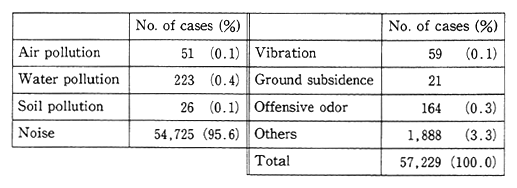
Source: Survey of the National Police Agency
Table 8 Police Handling of Environmental Pollution Complaints (1989)

Source; Survey of National Police Agency
Fig.4 Number of Arrest of Pollution Offense (1985 1989)
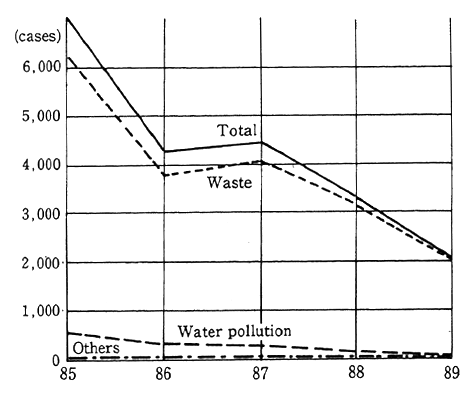

Note: Offenses of air pollution, soil pollution, noise, vibration and offensive odor are included in "others."
Source: Survey of National Police Agency
Table 9 Breakdown of Violation concerning Marine Pollution
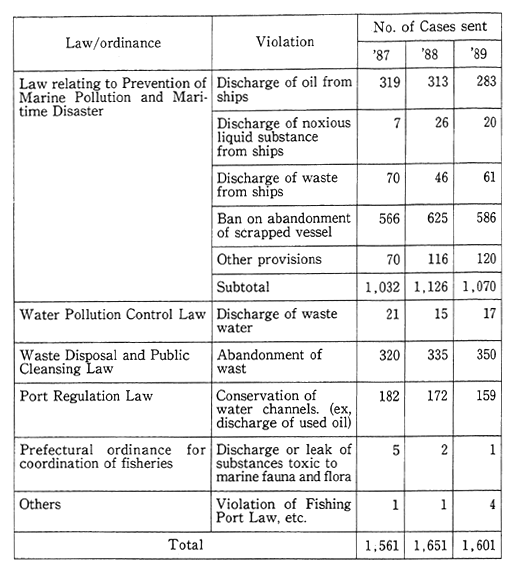
Source: Survey of Maritime Safety Agency
Table 10 Breakdown of Violation of Waste Disposal and Public Cleansing Law (1989)

Source: Survey of National Police Agency
3. Major Nature Reserves and Natural Parks
Fig. 5 Location of National Parks, Quasi-National Parks, and Nature Conservation Areas
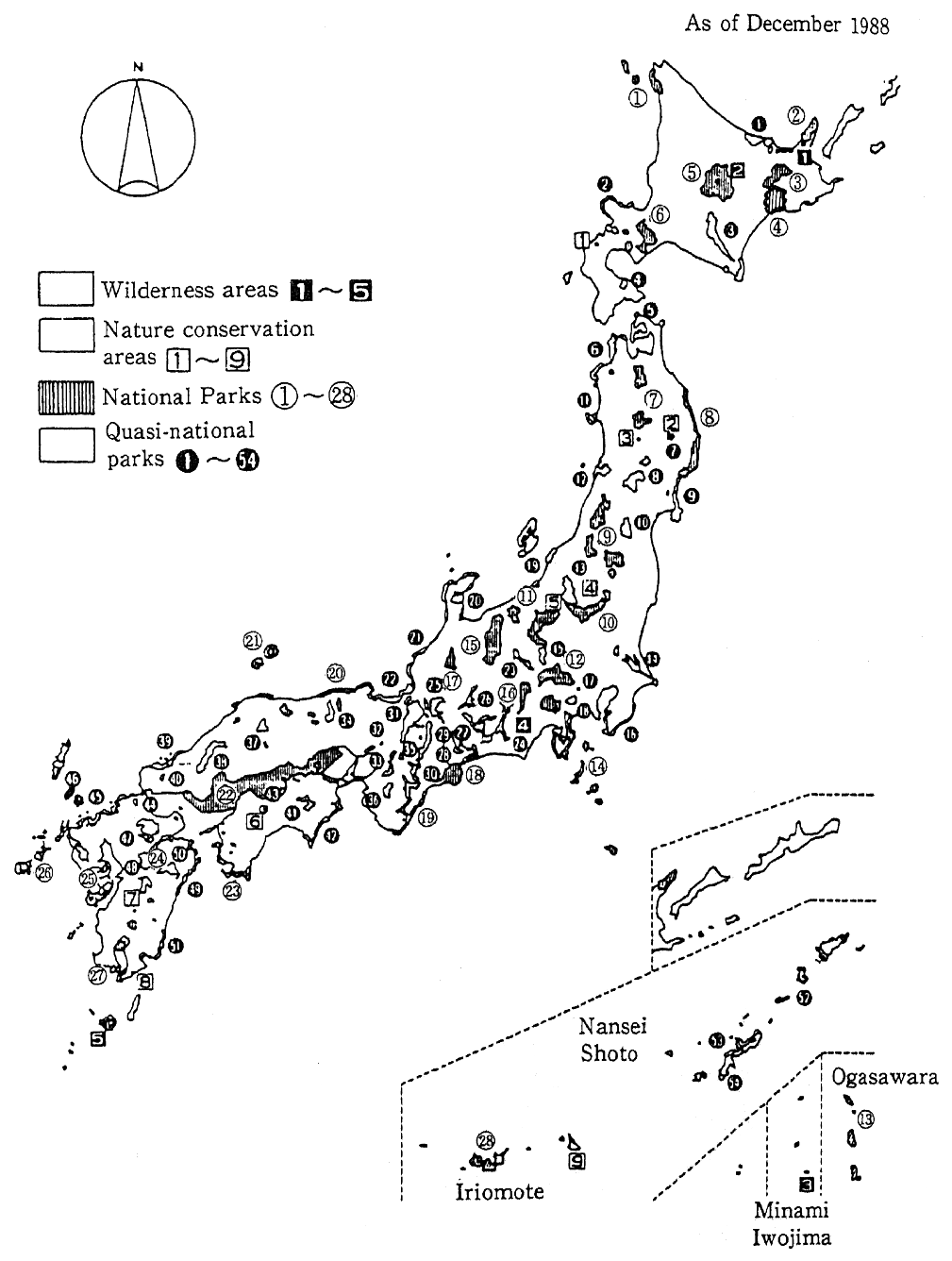
Table 11. Wilderness Areas
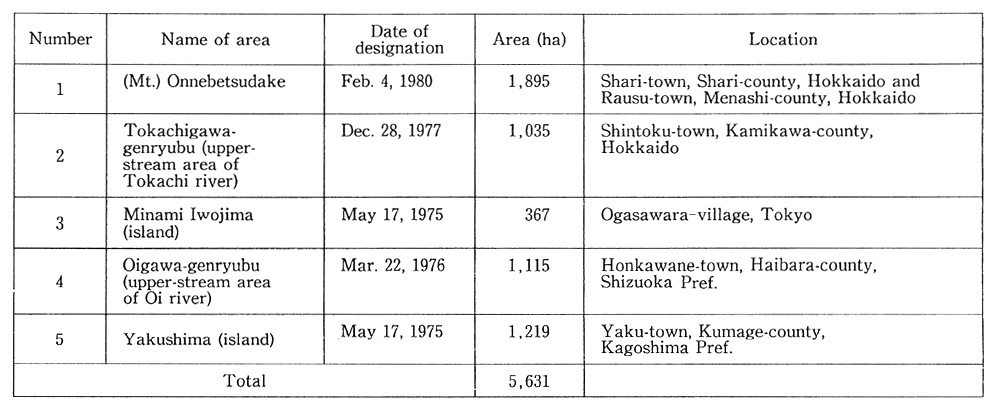
Table 12 Nature Conservation Areas
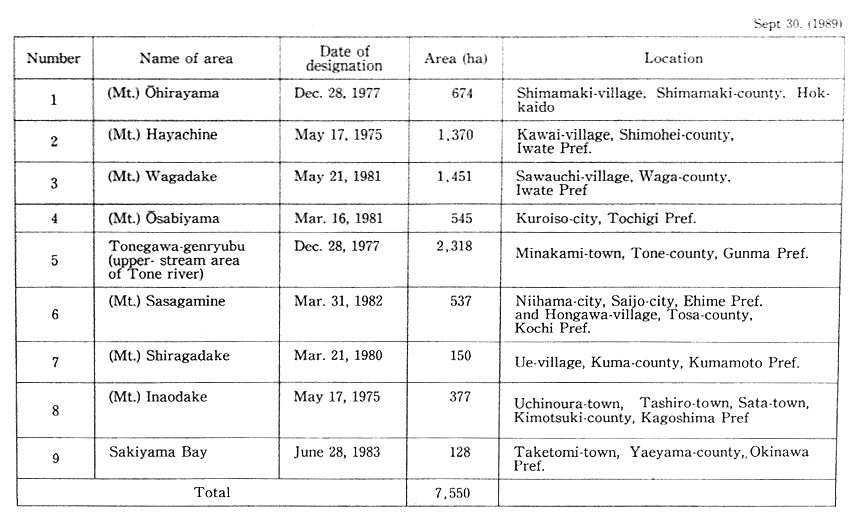
Table 13 National Parks
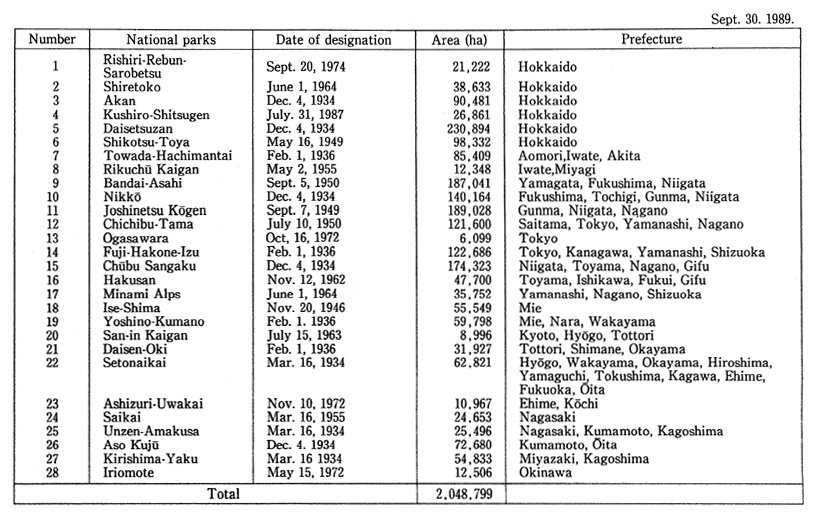
Table 14. Quasi-National Parks
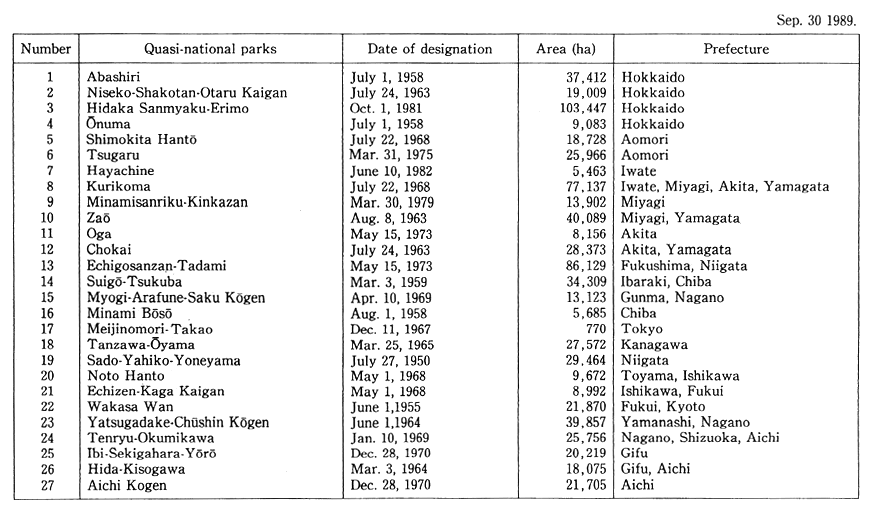
Table 14. (contd.)
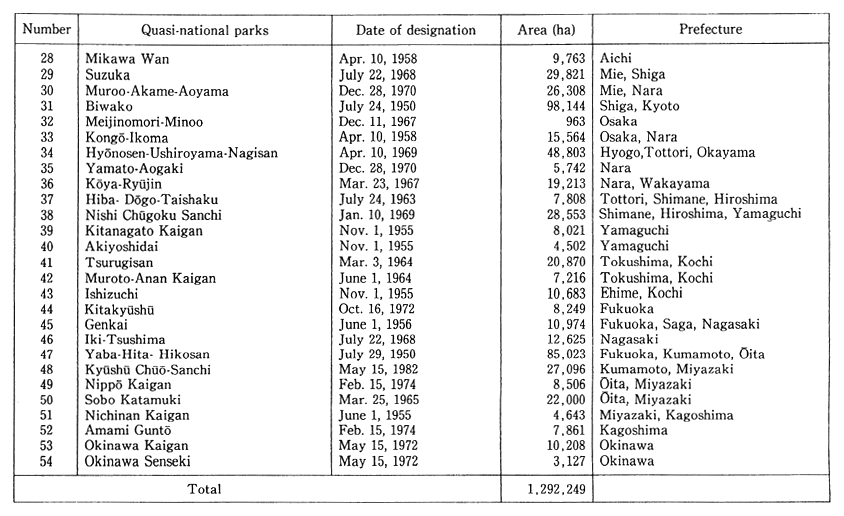
4. Environmental Administration by Local Government
(1) Manpower
Table 15 Number of Prefectural Personnel Responsible for Pollution Control

Note: The number of Part-time person is calculated by dividing the number of person who co-employed in the other job at the rate of the quantity of the person's job.
Table 16 Number of Prefectural Personnel Responsible for Nature Conservation

Note: The number of Part-time person is calculated by dividing the number of person who co-employed in the other job at the rate of the quantity of the person's job.
Table 17 Number of Municipal Personnel Responsible for Pollution
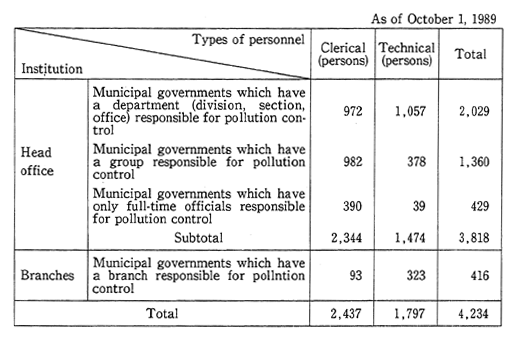
Control (Full-Time only)
(2) Budget and Public Financing
Table 18 Budget for Environmental Pollution by Local Governments in 1988 (Final)
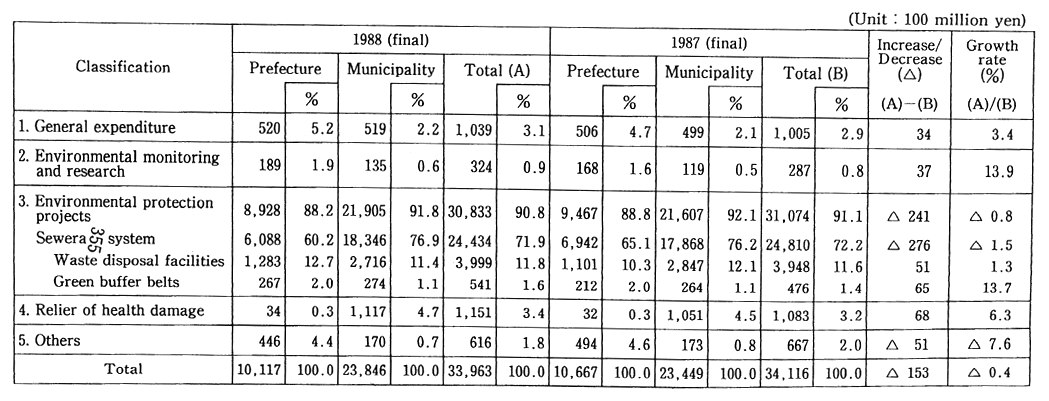
Note: The "budget (final)" is gained by deducting duplications between the prefecture and municipality.
Source: Survey of Ministry of Home Affairs
Table 19 Financial Assistance for Pollution Control Facilities by Local Governments (1988)

Table 20 Subsidies for Pollution Control Facilities by Local Governments (1988)

(3) Ordinance and Environmental Agreement
Table 21 State of Enactment of Ordinances for Environmental Conservation in Municipal Governments

Table 22 Number of Pollution Control Agreements by Types of Industries
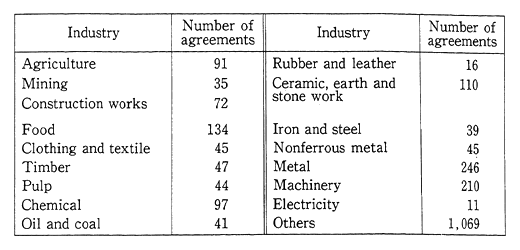
Note: The breakdown of the agreements concluded from October 1,1988 to Septem-ber 30. 1989.
Table 23 Details of Pollution Control Agreements

Note: The breakdown of the agreements concluded from October 1, 1988 to Septem-ber 30. 1989.
Table 24 Residents' Participation in Pollution Control Agreements

Note: The breakdown of the agreements concluded from October 1, 1988 to Septem-ber 30, 1989. Under an environmental pollution control agreement, it is possible to carry out measures against environmental pollution in an elabor-ated manner, depending on the geographical and social conditions of the given community. From the standpoint of a business, it would be virtually impossible to operate a plant without a consent of the community residents at the time of its location.
5. Environmental Monitoring Air (As or March 1987)
Table 25 Air Pollution Monitoring
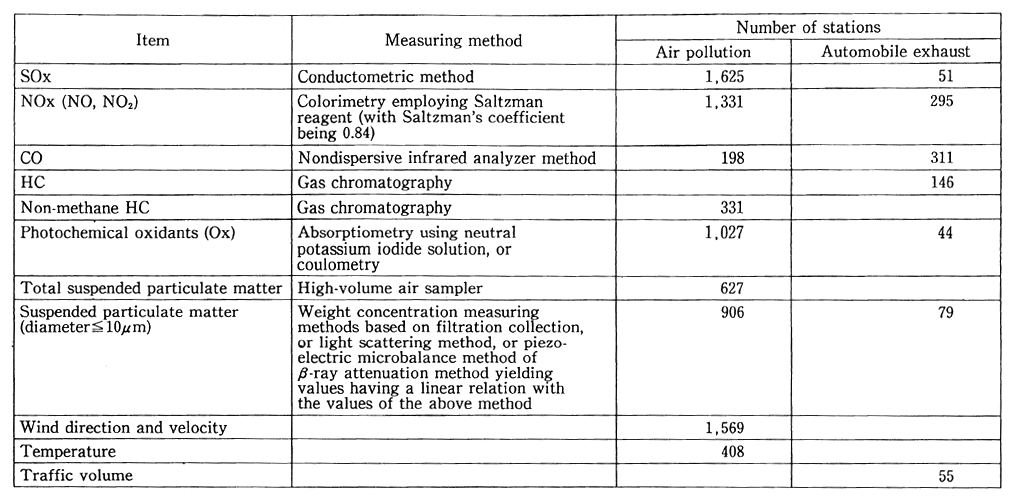
Appendix4. Major Environmental Issues In FY1989
Date Events
1989
Apr. 1 * Inclusion of musk was included in the category of rare wildlife in conjunction with the withdrawal of reservations in the Washington Convention. (Partial revision of the Law Concerning Controls, Etc., on the Trading of Endangered Wild Fauna and Flora)
* Opening of the Kiriu Nature Observation Forest
3 * Standards established for trichloroethylene and teratochlor-oethylene. Enacted on Oct. 1. (Promulgation of the Partial Revision of the Prime Minister's Ordinance for Effluent Standards)
4 * Standards, etc. established for the final disposal of indus-trial waste, including tricholoroethylene and teracholor oeythylene. Enacted on Oct. 1. (Promulgation of the Partial Revision of the Ordinance for Execution of the Waste Disposal and Public Cleaning Law and the Ordinance for Execution of the Law Concerning the Prevention of Marine Pollution and Marine Disasters)
13 * Release of the report "Some proposals on the Life Friendly to the Environment" prepared by the Study Group on Life and the Environment
16 * Changes in the form of wildlife breeding permits for the appropriate control of bred wildlife (Partial revision of the Regulation for Execution of the Law) Concerning Wildlife Protection and Hunting Law
18 * The 48th OECD Environment Committee (Paris, Apr. 18-30)
20 * Opening of Oono Nature Observation Woods
25 * The Council for Promotion of Measures for Conservation of the Oze Area in the Nikko National Park (taken part in the Environment Agency, Gunma Prefecture, Fukushima Pre-fecture, Niigata Prefecture and related villages) decides to suspend one of the climbing routes to Mt. Shibutsu and carry out the sensor monitoring of the number of visitors.
26 * Changes in the Program for Construction of the New Ishigakijima Airport in Okinawa Prefecture announced.
* The EA releases the report On the Findings of the FactFinding Survey on the Habitation of Coral Around Ishigakijima, Etc.
* The First Conference of Signatories to the Vienna Convention and the Montreal Convention is held in Helsinki.
Necessary controls for the enforcement of the conventions are determinded, and the Helsinki Declaration is adopted to politically agree to the total abolition, etc. by the signatories of specified chlorofluorocarbons by the end of this century (the conference is attended by the Administrative Vice Minister of the Environment on behalf of the Japanese Government).
27 * An announcement on "Important Inhabiting Sites for Native Living Things"
28 * The EA releases the Report by the Green Land Function Study Group on the Atmospheric Environment and the Guideline for Afforestation for Air Purification.
May 3 * The Ninth U.S.-Japan Joint Planning and Coordination Committee (attended by the Director-General of the Environment Agency on behalf of the Japanese Government. Washington on May 3-5)
8 * The Society to Talk With Nature at Koshimizu, a foundation, is recognized as a nonprofit foundation for nature conservation.
10 * The 43rd Bird Week (May 10-16)
12 * The EA releases the Survey Report for Promotion of the Dissemination of Electric Automobiles.
* The Cabinet orally agrees on establishing a council of ministers for global environment consevation.
14 * The Director-General of the EA attends the national convention for the protection of wild birds (Omiya City, Saitama Prefecture).
15 * The 15th UNEP Governing Council 'attended by the Vice Minister of the EA)(Nairobi, May 15-26)
18 * The Global Environment Conservation Planning Promotion Headquarters in the EA releases an interim report.
* The first meeting of chairman of the Second Working Group of the Intergovernmental Panel on Climate Change(IPCC) is held (Moscow, May 18-19)
19 * The Cabinet approves and presents to the Diet the White Paper on the Environment, entitled Aiming for Cities with Harmony Between Man and the Environment.
24 *The Stuady Subecommittee on the Utilization of the Natural Park Panel of the Natural-Environment Conservation Council releases the report On the Utilization of Natural Parks
25 * The National Liaison Council on Domestic Waste Water Measures holds a general assembly. (Matsue City, Shimane Prefacture, May 25-26)
30 * The Ministerial Council of the International Energy Agency (IEA) Ministerial Council holds the 12th meeting. (Paris)
31 * The Asian-Pacific Regional Seminar on Protection of the Ozone Layer is held under the conponsorship of the UNEP, UNU and the Japanese Government. With the participation of 12 developing and other Asian countries, recommenda-tions which are to serve as a guideline for the Asian-Pacific region are adopted to related governments, industries and international organizations.
June 1 * The EA announces the "Survey on the Capacity of Trees to Purify Air" by junior high school students which was car-ride out as one of the Environment Week events.
* The Month for Conservation of the Seto Inland Sea's Environment (June 1-30)
* The China-Japanese Environment Conference (attended by the Director-General of National-Environment Conserva-tion in the Chinese Government and the Administrative Vice Minister of the EA of Japan. Tokyo)
* The National Council for Promotion of Amenities holds a general assembly. (June 1-2)
3 * The Fourth Low Pollution Car Fair is hold. (June 3-4)
4 * The 17th Environment Week (June 4-11)
* A ceremony for the presentation of the Environment Prizes
6 * The Environment Week Convention (commendation of contributery to environment conservation, lecture meetings, etc.)
7 * The Water Environment Forum '89 is held. (Tokyo)
* The EA holds the International Environment Symposium for the Asian Region (Tokyo)
16 * The EA releases the Findings of the Survey on Big Trees in the Fourth Basic Survey for Conservation of the Natural Environment (bulletin).
20 * The Fifth Australian-Japanese Conference on the Protec-tion of Migratory Birds, Etc. (Tokyo, June 20-21)
* Lake Kucharo (Hokkaido) was designated as a new "Ram-sar site."
* The area of marshland for the Kushiro Marshland ragis-tered as a Ramser site is broadened.
22 * The EA establishes a Roundtable Conference for Promotion of Methanol Automobiles.
23 * The Director-General of the EA inquires the Central Council for Environmental Pollution Control on the Designation of Substances with Offensive Odor and Decision on the Scope of Control Standards.
26 * The EA releases the First interim report by the Study Group on Global Warming (the Working Group for Environ-mental Quality Assessments and the Working Group on Measures).
27 * The Subcommittee on Measures Against Air Pollution by Nitrogen Oxides in the Environment Committee of the Liberal-Democratic Party's Policy Affairs Research Council releases the Proposal for the Strengthening of Measures Against Nitrogen Oxides.
28 * The controls on emission of asbestos was enacted. (The Partial Revision of the Air Pollution Control Law is promul-gated, going into effect on December 27.)
* The second meeting of IPCC is held. (Nairobi, June 28-30)
* A ban on the underground permeation of water containing hazardous substances measures in accidents were enacted and set in force on October 1. (The Law for the Partial Revision of the Water Pollution Control Law is promulgat-ed.)
29 * The EA releases the Survey Report on the Water Quality of Major Bathing Areas Across the Country.
30 *The Council of Ministers for Global Environment Conserva-tion agrees on Measures for Conservation of the Global Environment.
July * Events for the Month for Promotion of the Rational Utiliza-tion of Specified CFCs are promoted primarily by the Council for Promotion of the Rational Utilization of Speci-fied CFCs (for a month).
10 * The EA releases the report The Actual Status of Soot Disposal Equipment in Fiscal 1987
12 * The public interest arises as the idea of collecting fees for admission to Ose are reported by the press.
14 * The Arche G7 Summit (Paris, July 14-16)
19 * The EA releases the Interim Report of the Study Group on Measures Against Hazardous Waste.
20 * Permission is granted for the establishment of the Japan Environmental Technology Association.
* The EA announces on the outline of routes for the Tohoku Nature Trail (New Oku-no-Hosomichi).
21 * Notes are exchanged on grant assistance in the Thai Envi-ronment Research and Training Center.
* The EA serves notice on Partial Revisions in the Designa-tion of Lakes and Reservoirs Associated With Effluence Standards for the Contents of Nitrogen and Phosphorus.
26 * The EA releases the Outline of the Environmental Survey on Triphenyl Tin Compounds in Fiscal 1988.
* The 31st National Parks Convention (Shigashima National Vacation Village in the Genkai Quasi-National Park, July 25-27)
* The Council of All Prefectural Governors and Municipal Mayors for Conservation of the Natural En in the Seto Inland Sea holds a general convention. (Hiroshima City)
Aug.8 * The EA releases the Policy for Conservation of the Oze Area (at the Council for the Promotion of Measures for Conservation of the Oze Area in the Nikko National Park).
11 * The National Symposium by Municipalities on the Conser-vation of the Water Environment (Kurobe City, Toyama Prefecture, Aug. 11-12)
14 * The EA releases the report On the Findings of the First Survey on Acid Rain.
21 * The Working Group Based on the Montreal Protocol meets in Nairobi. The first series of studies are made on the framework of financial aid to developing countries. (Aug. 21-25)
25 * The EA releases the report "A View on the Panel Report on Scientific Findings Based on Article 6 of the Montreal Protocol" by the Panel on Reactions, Impacts and Monitor-ing in the Study Group on the Protection of Stratospheric Ozone.
* The EA releases the report On the Findings of the Monitor-ing of the Concentrations of Nitrogen Dioxide in Areas with Controls on the Areawide Total Pollutant Load in Fiscal 1988.
29 * The Working Group Based on the Montreal Protocol meets in Nairobi. The first series of studies on revision of the protocol is conducted. (Aug. 28-Sept. 5)
* The Study Group on Measures to Control the Exhaust of Nitrogen Oxides from Automobiles is established in the Air Quality Bureau.
* The EA releases the Survey on the Enforcement of the Air Pollution Control Law in Fiscal 1987.
Sep. 1 * The Baltic Sea is additionally is included in the category of special seas where strict controls are exercised on the discharge of waste from ships, etc. (The Administration Ordinance for the Partial Revision of the Law Relating to the Prevention of Marine Pollution and Maritime Disasters is promulgated.)
4 * The Central Council for Environmental Pollution Control filed with the Director-General of the EA a recommenda-tion, entitled On the Designation of Substances With Offen-sive Odor and the Establishment of the Scope of Control Standards.
6 * The EA releases the Outline of the Findings of the Monitor-ing of Organisms (tributyl tin compounds).
8 * The Prime Minister instructs the formulation of an environ-mental pollution control program for the fifth area (the area of the Bay of Sendai and seven other areas).
11 * The Tokyo Congress on Conservation of the Global Envi-ronment is jointly held by the Japanese Government and the UNEP. (Sep. 11-23)
14 * The "Communities for Communion with Nature and Native Living Things" project is approved.
18 * The Working Group Based on the Montreal Protocol meets in Geneva. A work including the establishment of an infor-mation network, etc. is studied. (Sep. 18-19)
* The Fifth Section (chaired by Michio Hiashimoto) of the Second Working Group of the IPCC holds the Lead Author Conference. (Tsukuba, Sep. 18-21)
19 * The U. N. General Assembly opens the 44th session. (New York, Sep. 19-Dec. 23)
25 * The Joint World Bank/IMF Development Committee opens the 37th conference. (Washington)
27 * New Substances with Offensive Odor were designated. (The Administrative Ordinance for the Partial Revision of the Ordinance for the Enforcement of the Offensive Odor Con-trol Law is promulgated. and set in force on Feb. 4, 1990)
* The First Japanese-Soviet Conference on the Protection and Study of Migratory Birds, Etc. (Moscow)
29 * The directors of the International Waterfowl and Water. lands Research Bureau (IWRB) opens the 34th meeting. (Astrakhan, USSR, Sep. 29-Oct. 5)
Oct. 1 * The Day of "Jokaso"
2 * The Eighth Nationwide Convention "Let's Walk Along Nature Trail."
* The Third Working Group of the IPCC opens the second meeting. (Geneva, Sep. 2.6)
3 * The International Symposium on Measures for the Urban Environment in Developing Countries is held. (Oct. 3-6 in Kita-Kyusyu City)
9 * The International Parliamentarian Forum on Conservation of the Global Environment is held. (Oct. 9-10)
* The Seventh Conference of Signatories to the Washington Convention is held. (Lausanne, Oct. 9-20)
11 * The LA releases the Follow-up Survey on the Actual State of Pollution by Hazardous Chemicals in Fiscal 1988.
25 * The 10th Symposium on the Comfortable Environment is held under the theme of Aiming at City with Harmony Between Man and the Environment. (Nagahama City, Oct. 25-26)
26 * The Second Symposium "Let's Talk About Big Trees" Oki Island, Shimane Prefecture)
29 Dispatch of the government's environment mission to four Southeast Asian countries (Malaysia, Thailand, India and the Philippines). (Oct. 29-Nov. 16)
31 * The Second Working Group of the IPCC opens the second conference. (Geneva, Oct. 31-Nov. 3)
* The Council of Ministers for Global Environment Conserva-tion agrees on the Comprehensive Promotion of Surveys and Researches, Monitoring, Surveillance and Technical Development for Global Environment conservation.
November to February Implementation of measures against seasonal air pollution
Nov. 1 * The EA designates the State-Established Tsurugi Moun-tains Wildlife Protection Area, the State-Established Kii-Nagashima Wildlife Protection Area and the State-Established Seinan Wildlife Protection area.
6 * The Ministerial Conference on Air Pollution and Climate Change is held under the sponsorship of the Dutch Govern-ment. Attended by the Director-General of the Environment Agency on behalf of the Japanese Government. (Noordwijk, the Netherlands, Nov. 6-7
7 * The Noordwijk Declaration on Climate Change * Japan returns crested ibises "Huahua" to China.
8 * The China-Japan Conference of Specialists for Cooperation in the Protection of Japanese Crested Ibises (Nov. 8-9, Beijing)
10 * The Symposium on Environmental Education is held under the theme of "Talking about Environmental Education." (Tokyo)
13 * The Working Group Based on the Montreal Protocol meets. The second series of studies is made on the revision of the protocol on the strengthening of controls, etc. (Nov. 13-17)
16 * The EA serves notice on the "Revision of Standards for Reservations in the Registration of Pesticide Residues in Crops."
22 * The EA released the report On the Public Invitation of the Nickname of the Public-Information Character for the Protection of the Ozone Layer and its results. A ceremony for the presentation of awards for excellent works is held in the Office of the Environment Agency Director-General.
30 * The EA and the Ministry of Health and Welfare issue a public notice on the "Management of the Former Sites for the Final Disposal of Waste." * The additional inclusion of estuary crocodiles in the cate-gory of rare wild faunal and flora due to the withdrawal of reservations for the Washington Convention. (The partial revision of the Ordinance for the Enforcement of the Law Concerning the Control, Etc. on the Trading of Endangered Wild Fauna and Flora.)
Dec. 1 * The EA carries out the "Project for Forecast on Nitrogen Dioxide" on television and by radio. (Dec. 1-27) * Dispatch of the government's environment mission to four East European countries (Poland, East Germany, Czechos-lovakia and Hungary) (Dec. 1-14)
2 * The Director-General of the EA attends events in the cam-paign for the prevention of urban air pollution (Shibuya 109).
* the U.S.-Soviet Summit (Malta, Dec. 2-3)
8 * The Director-General of the EA announces on the adjust-ment of individual Japanese serows.
* The Findings of the Sensor Survey on the Number of Visitors to the Oze Area in the Nikko National Park are released.
11 * The Director-General of the EA inquires the Central Council for Environmental Pollution Control about the "Way the System Associated with Measures Against Domestic Waste Water Ought To Be."
* The EA released the Study and Survey on the Environmen-tal Reside of Designated Chemicals in Fiscal 1988.
* The EA releases the Outline of the Findings of the Survey on Tributyl Tin Compounds in the Seto Inland Sea.
12 * The EA releases the Survey Report on the Noise of Auto-mobiles in Fiscal 1988. * The OECD Environment Committee holds the 49th Confer-ence. (Paris, Dec. 12-24)
13 * The EA releases the 1989 Edition of Chemicals and the Environment.
14 * The EA releases the state of the Discharge of Trichlor-oeythlene and the State of the Pollution of Underground Water.
* The EA releases the report on the Enforcement of the Water Pollution Control Law in Fiscal 1988.
* The Director-General of the IRA attends an environment symposium. (Ichinoseki City)
15 * The Okinawa District Court decides not to prosecute an Asahi Shimbun reporter in the infliction of damage on coral.
17 * The International Conference on Preparations for Climate Change (Cairo, Dec. 17-21)
19 * The findings of the monitoring survey on controlled air pollutants as of the end of fiscal 1988 are released.
* The EA releases the Related Data on Conservation of the Environment With Functional High Molecules
* The EA releases the Findings of the Survey on the Water Quality of Waters for Public Use in Fiscal 1988.
20 * The EA releases the Outline of the Report on the Findings of Air Pollution Monitoring Stations in Fiscal 1988
* The EA releases the Findings of Monitoring by the Automo-bile Exhaust Gas Monitoring Stations in Fiscal 1988.
* The EA releases the Outline of Photochemical Air Pollution --Status Report on Damage
* The outline of the Findings of the Survey on the Selected Species of Fauna and Flora Requiring Urgent Protection (the Japanese version of the Red Data Book [1st Edition]).
21 * The EA releases the Findings of Precision Survey on Measures Against Farmland Soil in Fiscal 1988. * The EA releases the Outline of Areas with Land Subsidence Across the Country in Fiscal 1988
22 * Ther amounts of the juvenile compensation and the reciper-ation allowance are raised. (The Administrative Ordinance for the Partial Revision of the Ordinance for the Enforce-ment of the Law Concerning the Compensation of Pollution-Related Health Damage is promulgated.)
* The Central Council for Environmental Pollution Control files with the Director-General of the EA a recommenda-tion, entitled The Way the Reduction of Automobile Exhaust Gas Ought To Be in the Future.
27 * The EA issues the notice on the Determination of Methods to Monitor the Concentrations of Asbestos.
* The EA issues the notice on the Determination of the Frequency of Monitoring of Asbestos.
* bis (tributyl tin) = oxido (TBTO) is designated as a Class I specified chemical, and 7 kinds of TPT compounds are designated as Class II specified chemicals. (The Adoministrative tive Ordinance for the Partial Revision of the Law Concern-ing Examination and Deregulation of Manufacture. Etc,of Chemicals is promulgated and put into effect on January 6, 1990.)
1990
Jan 4 * The EA releases the Findings of the Survey on the Sources of Natural Scenery in the Third Basic Survey on Conserva-tion of the Natural Environment
5 * The EA announces on the execution of the Survey on Nearby Living Things in the Fourth Basic Survey on Con-servation of the Natural Environment.
15 * The EA carries out Star Watching Network events. (Jan. 15-28)
18 * The additional inclusion of 42 species in 3 geneses in the category of rare wildlife due to the revision of the protocol to the Washington Convention. (The partial revision of the Ordinance for the Enforcement of the Law Concerning Controls on the Trading of Endangered Fauna and Flora)
19 * The EA releases the interim report On Technology for Destruction of CFC by the Panel on Curbs on Discharge and Destruction Technology, Etc. in the Study Group on the Protection of the Stratospheric Ozone Layer.
Feb. 1 * Arrangements are completed for the budgets associated with global environment conservation in the draft govern-ment budget of 1990.
5 * The IPCC holds the third meeting. (Washington, Feb. 5-7)
8 * The EA releases the Status Survey on Environmental Pollution by Offensive Odor in Fiscal 1988.
* The EA releases the Status Survey on the Enforcement of the Noise Control Law in Fiscal 1988.
* The EA releases the Status Survey on the Enforcement of the Vibration Control Law in Fiscal 1988.
14 * The EA releases the Application of Biotechnology in the Conservation of the Environment.
15 * The Environmental-Conservation Vision Symposium is held under the cosponsorship of the Environment Agency, Tokyo Metropolitan Government and Japan Environment Associa-tion under the theme of the "Conservation of the Global Environment and Global-Environment Policy."
19 * The Second UNEP Conference of Experts on Biological Diversity (Geneva, Feb. 19-13)
* The Second Japan-Republic of Korea Environment Sympo-sium (Kita-Kyusyu City, Feb. 19-20)
26 * The EA releases the 29th Survey on Birds in the Families of Wild Geese and Ducks.
* The Lead Author Conference of the First Working Group of IPCC is held. (Edinburgh, Feb. 16-Mar. 2)
* The second conference of chairmen of the Second Working Group of the IPCC. (Moscow, Feb. 26-Mar. 2)
* The Working Group Based on the Montreal Protocol meets in Geneva. The second series of studies on the framework of financial aid to developing countries is conducted. (Feb. 16-Mar. 5)
Mar. 5 * Japan transfers a Japanese ibi "Midori" to Beijing Zoo in China.
8 * The Working Group Based on the Montreal Protocol meets in Geneva. The third series of studies on the revision of the protocol, such as for a strengthening of the controls, is conducted. (Mar. 8-14)
12 * The IMO Oceanic Environment Protection Commission holds the 10th meeting. (London, Mar. 12-16)
* The EA releases the Results of the Project on the Forecast of Nitrogen Dioxide in Fiscal 1990 (bulletin).
13 * The Prime Minister approves the environmental pollution prevention program for the fifth series of areas (the area of the Bay of Sendai and seven other areas).
* The Prime Minister approves the Lake Water Conservation Program for the lakes of Nakaumi and Shinji.
16 * The Central Council for Environmental Pollution Control files with the Director-General of the EA a recommenda-tion, entitled the "System Associated With Domestic Waste Water."
21 * The First Basic Design Survey Team on the China-Japan Friendship Environment Conservation Center is dispatched. (Mar. 21-30)
29 * The Research/development agreement for project-style technical cooperation is concluded with the Thai Environ-mental Research and Training Center.
* The EA compiles and releases the Annual Report on the Results of the Monitoring of the Ozone Layer, Etc. in accordance with the Ozone Layer Protection Law.
* The directors of the Councils of Ministers for Global Envi-ronment Conservation agree on the "Promotion of Dissemi-nation, Enhancement, Etc., for, Global Environment Conser-vation."
* The Overseas Environment Cooperation Center is estab-lished.
30 * The amounts of compensation for certified patients suffered by pollution are raised, and the change rates for compensa-tion fund for fiscal 1990 are determined. (The Partial Revision of the Ordinance for the Enforcement of the Law for Pollution-Related Health Damage is promulgated.)